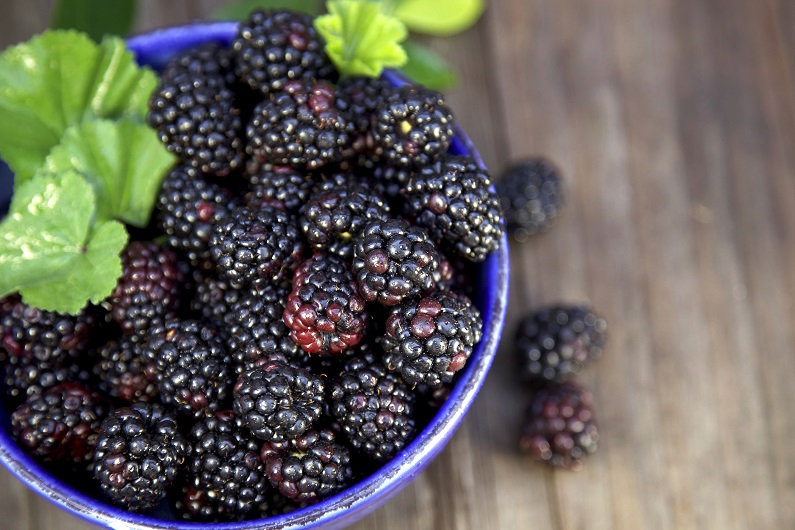Black raspberry is a relatively rare guest of our summer residents and gardeners. No one is surprised by the yellow variety. But her black sister is often confused with blackberries. Breeders bred garden blackberry varieties, black raspberries, so a person unfamiliar with their differences, it is difficult to say with certainty where the raspberries, and where - blackberries.
In this article, we will look at the Cumberland black raspberry variety, its distinction with the blackberry, as well as the care methods.
Table of contents
The difference between black raspberry and blackberry
Consider the main differences between black raspberries and blackberries.
- To quickly figure out which bush is growing in front of us, you need to pick a fruit. Raspberries, whether red or black, have a hollow interior. Berry breaks down, and the receptacle remains on the branch. The blackberry has a receptacle that cuts off with the berry, and it does not remain empty.
- According to the shape of the berries blackberries are more like red raspberries, having the same oblong shape. The black hemispherical fruit.
- They differ in time of ripening. Blackberries ripen a little later. Although in some cultivars, the collection time may be the same.
- Considering the plants, you can find differences in the stems. Blackberries have long (up to three meters) stems of green color with strong thorns. Blackberry bush is dense, resembles a tangle of hard wire. The black raspberry has a length of branches less (from one and a half to two and a half meters). Stems shorter, thinner and pale in color with blue. They have smaller spines than blackberries.
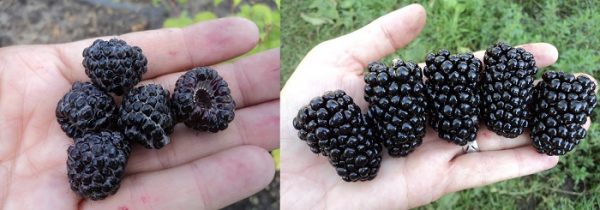
Raspberry hybrid with blackberry
Raspberries crossed with blackberries are called Tabery, bred in Scotland in the late seventies of the last century. It is obtained as a hybrid of blackberry and raspberry by pollination of the blackberry variety Aurora with raspberry pollen. As a result, elongated red-purple berries are grown, reaching six centimeters. Ezemalina Taiberry is famous for its yield, pleasant taste and aroma of fruits.
Shoots with small spikes grow to two and a half meters. The hybrid gives a crop from July to late fall. It is resistant to diseases, frost and pests. The basic principles of care and reproduction are similar to the cultivation of ordinary raspberries.
Black raspberry varieties
The first varieties of black berries were bred in America in the nineteenth century. In our country, the following types of popularity:
- Cumberland variety is the most common, obtained from the crossing of raspberries and blackberries.Differs in yield and early ripeness, has powerful long shoots, taking an arched shape. The large berries of blue-black taste like blackberries. The bushes are frost resistant, well tolerated in Russian winters, resistant to diseases and pests.
- The second most common variety, beloved by Russian gardeners - Boysenberry. The early variety is famous for its high yield of large sweet fruits. Lack of thorns on long shoots facilitates harvesting. Like Cumberland, the Boysenberry variety is frost resistant, rarely suffering from pests and diseases.
- New logan - Another variety that came to us from overseas. Although its height does not exceed two meters, it gives a good harvest of early berries. But in the winter of his shoots must be carefully sheltered from frost.
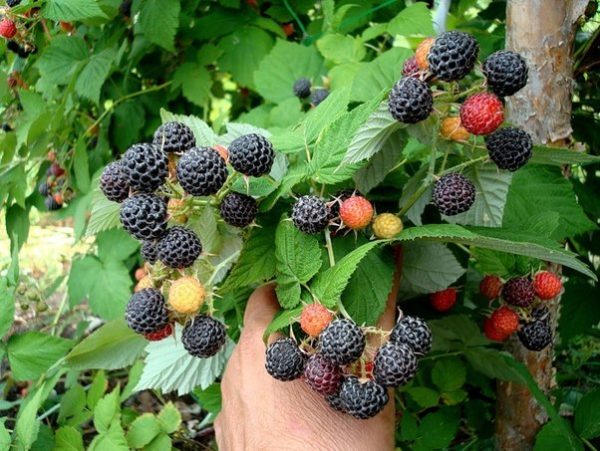
The tested varieties of foreign breeding are well competitive with new varieties bred by Russian scientists:
- Ember refers to the early varieties. It has a high yield, but its berries are small, sweet and sour.
- Sort Litch came to us from Poland, where he was obtained as a result of breeding in 2008.Small round berries have a characteristic gray bloom. Bushes are distinguished by long shoots with large thorns.
- Gift of Siberia It is famous for its winter hardiness and frost resistance, therefore it is recommended for planting in central Russia, Siberia and the Far East. Small berries have a dense structure and dessert taste.
- For more high-yielding varieties include Luck and Turngiving up to six kilos from a bush. The berries they are not large, but dense, long preserve the presentation.
Cumberland variety description
For example, the most popular and common varieties of black raspberry, consider its features. Berries of black color at this grade large, on weight reach 5-6 grams. The yield from one bush is up to ten kilograms at observance of the correct leaving that exceeds collecting from a bush of a red or yellow raspberry.
Although we are talking about the winter hardiness of the blackberry-like raspberry, it is still recommended to cover the bushes for the winter, sprinkle it with snow. Thanks to the shelter for the winter and early ripening, the black raspberry is taking root in different climatic zones of Russia. For the middle zone and the Non-Chernozem region, it is required to provide protection from cold winds and drafts when landing.
This allows it to tolerate dry periods well. But the lack of watering adversely affects the amount of the ovary and, accordingly, the crop.
Cumberland bushes, which are ripening densely dotted with ripe and ripening berries during the period of ripening, are a pictorial picture, therefore they will become an ornament in any garden. Their long shoots reach three meters, hanging down to the ground in the form of arches. The color of the stems acquires a gray bloom as it ripens, and the stems themselves are covered with thorns.
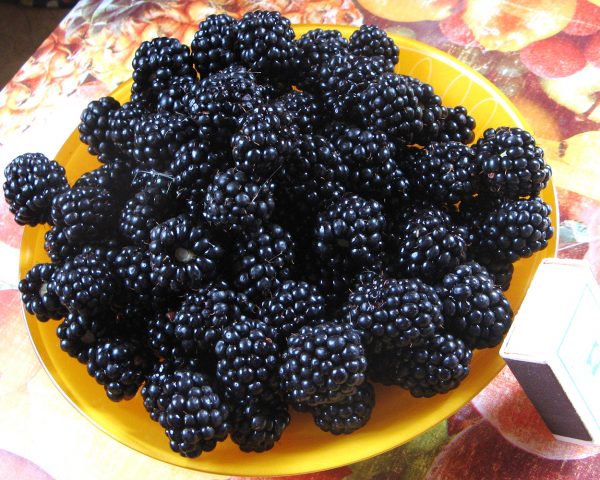
The advantages and disadvantages of black raspberries
Despite the not very widespread popularity, the black raspberry in many ways surpasses its relatives - red and yellow. Consider its main advantages:
- high yield;
- drought tolerance;
- resistance to pests;
- undemanding of soil composition;
- can serve as a hedge;
- does not form root scions, which allows it to be placed freely in the garden;
- berries have healing properties.
The disadvantages of blackberry-like raspberries include:
- her winter hardiness is less than that of the red variety;
- prone to viral diseases.
Useful properties of berries
Consider the useful properties of black Cumberland raspberry. In terms of the amount of vitamins and other beneficial substances, the black raspberry berries are superior to red and yellow. Blackberry-like raspberries are famous for their high content of rutin (vitamin P), which is necessary for vascular strengthening.
You might also be interested in the following raspberry articles:
Anthocyanins strengthen capillaries, clear vessels from sclerotic plaques. In addition, the fruits and leaves contain substances that reduce the level of prothrombin, which normalizes blood clotting. The berries are rich in trace elements - iron, manganese, copper.
Their taste is sweet and sour, reminiscent of a blackberry. Due to the dense structure of the fruit is stored for several days, well tolerated transportation.
Characteristic of the Tayberry variety
And now we will talk about the description of a grade of black raspberry. The appearance of the bushes is somewhat different from the usual red relative. Long shoots can reach three meters depending on the variety.Such long stems hang to the side, forming arched arches. Therefore, many gardeners carry out the garter stems to the trellis.
They are formed on annual stems. Therefore, for this species, it is necessary to carry out the correct pruning of lateral shoots and cutting in the fall of old stalks. Leave one-year stalks, which next year will give fruiting shoots.
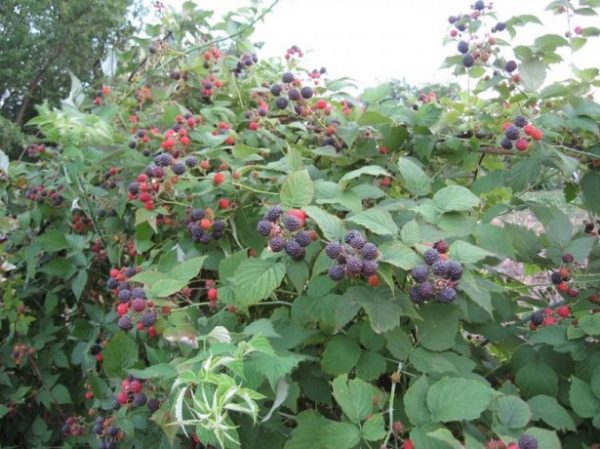
Growing and caring for black raspberries
Pruning in the fall
How to cut the black raspberries? It is recommended to perform double pruning during the season. At the end of June, the upper part of the shoots is cut at the height of human growth. This procedure will accelerate the formation of lateral fruiting shoots. Weak shoots are removed, preventing thickening of the bushes.
In the autumn, before the onset of frost, remove two-year shoots. Leave one-year-olds, which are shortened to half a meter above the ground.
Breeding
Propagating black berry is not so difficult. For reproduction used apical rations. For this, in early autumn, after the end of fruiting,long processes tilt and lay the tops in the prepared grooves up to ten centimeters deep, covered with earth.
Top cover with straw, sawdust. In the spring of cuttings take root and give shoots that are used as seedlings.
Planting seedlings
Planting hybrid seedlings is not much different from other species. First you need to choose a landing site and prepare it. The place should be protected from cold winds, to be sunny enough.
By planting a raspberry near the fence, you can provide it with protection from the cold and a support for growth.. At the same time, it can serve as a hedge due to durable spikes, which few people can decide to try.
Good predecessors will be the following garden crops:
- carrot;
- pepper;
- onion garlic;
- marigolds and marigolds.
You must observe the distance between the bushes, given the length of the shoots. In the same row the bushes are planted with a gap of about one meter, and between the adjacent rows - two meters.
Although black raspberries are not very demanding on the soil, loam, chernozem and sandy loam will be the best soils to achieve good yields. Saplings are planted in autumn (late September - early October) or in early spring.
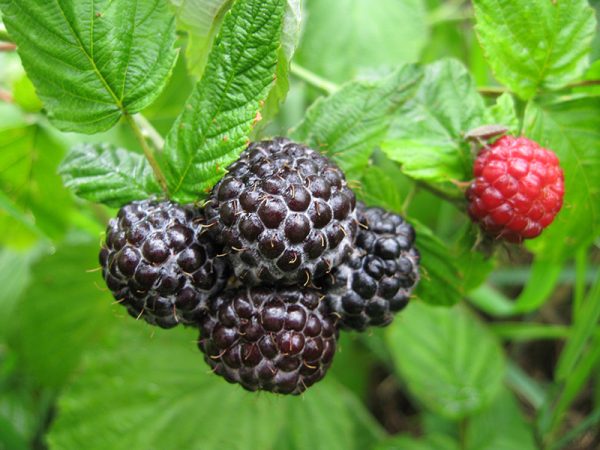
For planting seedlings need to prepare a hole half a meter deep. At the bottom of each pit bring a mixture of humus (6-8 kg), superphosphate (200 g), potassium sulfate (80 g). Mineral fertilizers can be replaced with wood ash (0.5 kg). The composition is mixed with the ground, make a mound. The sapling is set on its top, the roots are straightened down, sprinkled gently with earth, gradually compacting with their hands.
After watering the ground around mulch sawdust, straw, humus. The layer of mulch should be at least five centimeters.
To obtain powerful and at the same time compact plants, young annual shoots pinch at a height of half a meter, which stimulates the development of lateral shoots.
Fertilizer
Every three years it is recommended to fertilize plants with compost - about five kilograms under one bush.
After flowering, the first dressing is carried out with manure infusion (six parts of water are taken for one part of manure) or chicken manure (1:16 ratio of water). Wood ash (1 liter) and superphosphate (50 g) are added to the bucket of the infusion.Similar feeding done two more times - during the ripening and the beginning of the harvest.
Susceptibility to diseases and pests
Emalin is more resistant to diseases, less susceptible to insect pests than red. It is less likely to be affected by a disease characteristic of raspberry - verticillary wilt. This is a viral disease that cannot be cured. Affected bushes are cut, uprooted and burned.
To prevent infection, the spring is planted at a distance of at least ten meters from the red raspberry. It is recommended to organize soil drainage in rainy summer in order to prevent the development of fungal diseases. For prophylaxis, spraying of bushes with copper-containing preparations is carried out. Also use insecticides.
Emealen may be affected by anthracnose, which is manifested by white bloom on the leaves.. To combat apply fungicides, for example, Topaz, Mikosan or others, commercially available. Among the organic means of struggle used infusions and decoctions. Well proved decoction of horsetail.

One kilogram of grass is poured with a bucket of water, infused day. The next day, boil the composition for half an hour.For processing, the strained solution is diluted in a 1: 5 ratio. Horsetail can be replaced by nettles, but they insist not two days, but two weeks. Bred with the same proportion.
Of the pests, the most dangerous is the raspberry beetle. Prior to the awakening of the buds on the bushes, the first treatment is carried out with a solution of nitrophen (2% solution). The second treatment is performed with the appearance of flower buds infusion of wormwood and marigold. Two hundred grams of herbs poured a bucket of water, insist no less than a day.
As can be seen from the above, black raspberry refers to hybrids that combine all the best aspects of blackberry and red raspberry. Berries are famous not only for good taste, but also for healing properties. Bushes are characterized by high yield, unpretentiousness. Therefore, to care for the black berry for beginners is not difficult.
Now you know what is called black raspberry, you know its characteristics and methods of care for a hybrid.
